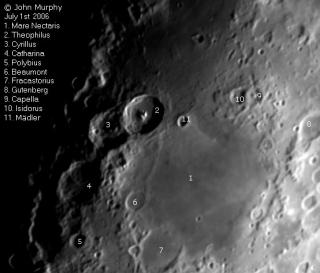| Old Town Sidewalk Astronomers | Whiteoaks Photo Albums | |
Observing Crater RosseJane Houston Jones |

Recently, I aimed my 12.5-inch reflector at the slender five day old waxing crescent Moon. My eye was instantly drawn towards a tiny crater in Mare Nectaris in the southeast quadrant of the Moon. Named for William Parsons, third Earl of Rosse, this small crater stands out despite its diminutive size. It has both a higher albedo than the surrounding lunar mare, and a signpost of sorts – a bright lunar ray appears to bisect it and cross the Nectaris basin.
In a few lunar days, the origin of this ray will become apparent. It's part of the massive ray structure from Tycho. At full Moon, you can see this ray span over 1800 kilometers from Tycho to Rosse. Bowl-shaped Rosse, 12 kilometers in diameter, according to Antonin Rukl's Atlas of the Moon, is easily visible for much of the lunar month. I have enjoyed viewing it as a bright speck on the waxing crescent terminator, as part of the vivid lunar tapestry of the full Moon, and at sunset on the waning Moon a few days after full.
The Sea of Nectar (Mare Nectaris) is a small lunar mare or sea, a volcanic lava plain noticeably darker than the rest of the Moon's surface, located between the Sea of Tranquility (Mare Tranquillitatis) and the Sea of Fecundity (Mare Fecunditatis). Montes Pyrenaeus borders the mare to the west. To the southwest is the large, flooded Fracastorius crater.
I love to aim my telescope at this small but significant crater because it reminds me of my visit to the 72-inch Leviathan reflector telescope and the great time we had in Ireland at the 2006 Whirlpool Star Party.
Copyright © 2006 Jane Houston Jones
Last updated: